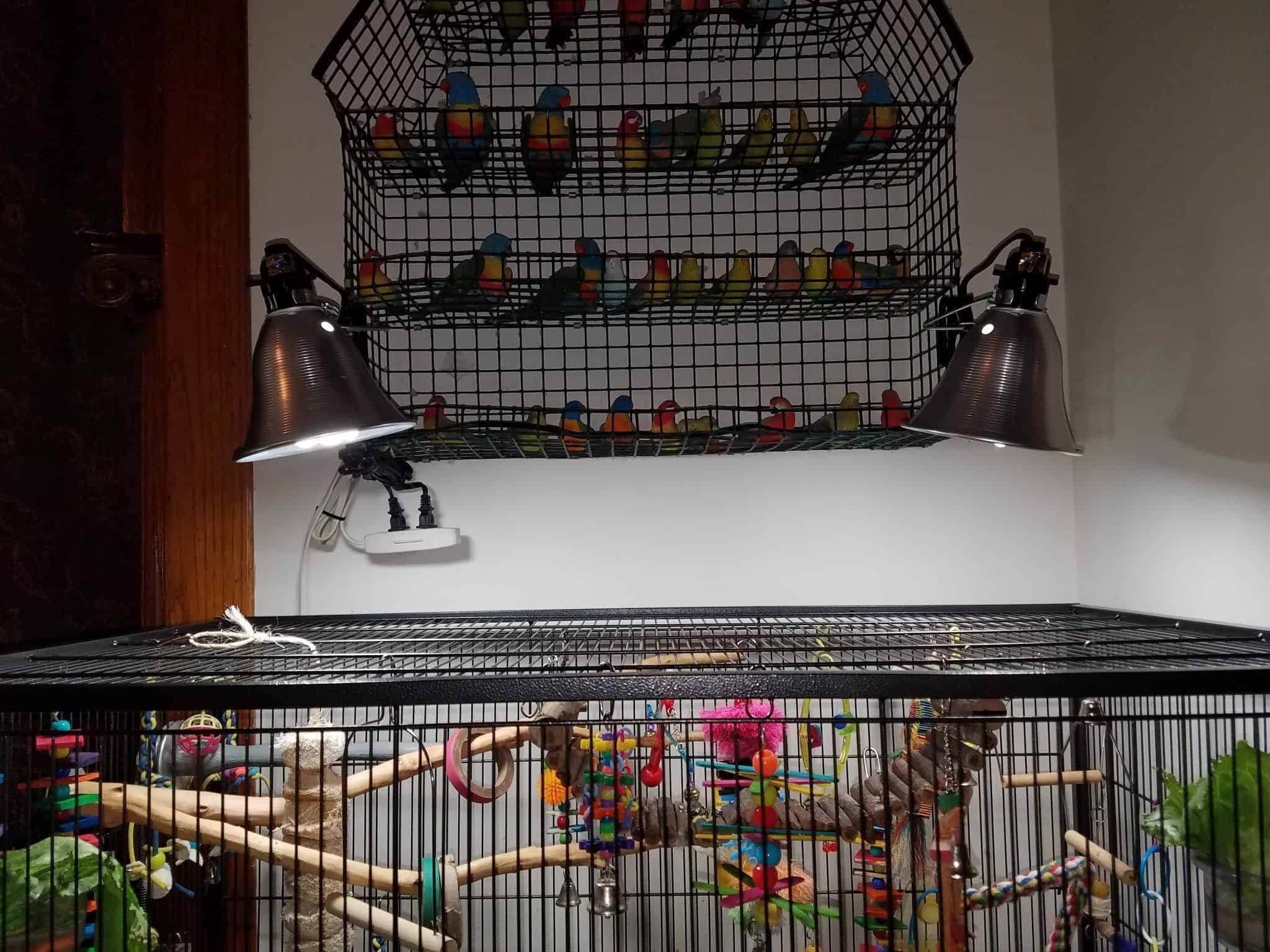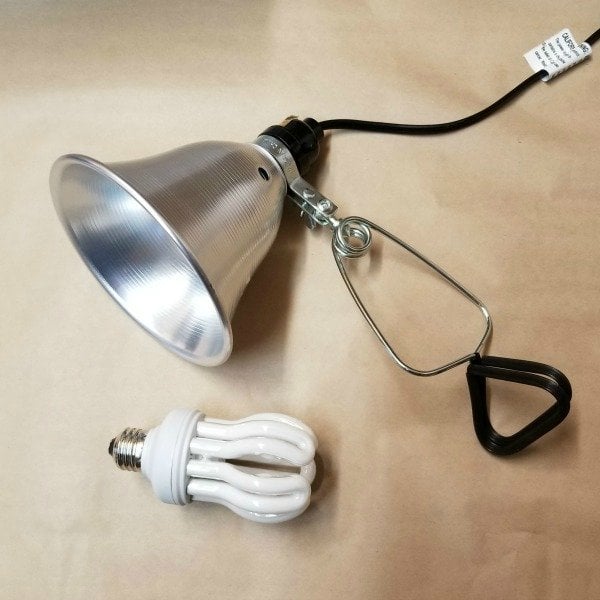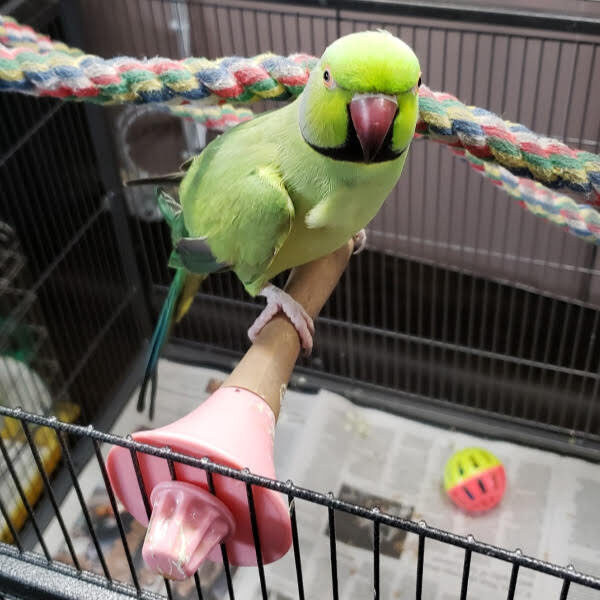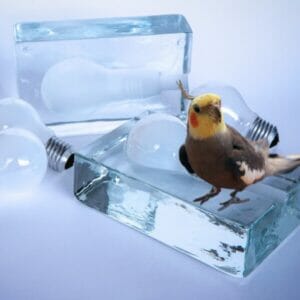Last Updated on by Mitch Rezman
Over the past few years, we’ve been emphasizing the proper use of man-made lighting and its effect on pet birds.
Search results when googling the term “pet bird lighting” predominantly yield links to products relating to lighting for pet birds.
With the exception of Windy City Parrot and the Lafebers blog, it is difficult to find information about pet birds and the many ways light affects them.
Even on Lafeber’s blog post, you’ll find just a couple of hundred words about using lighting as a birdcage accessory talking about the overall subject of creating your bird’s home.
The blog goes on to erroneously state that the oil coming from a parrot’s uropygial gland is ingested by birds which becomes nourishment.
The blog also states that spreading this oil with its beak over a bird’s feathers then awaiting sunlight, somehow miraculously morphs into a usable form of vitamin D3.
How the preening oil gets from the bird’s feathers to the bird’s digestive system is a bit opaque in the article.
I’m not saying that vitamin D3 can’t be synthesized through the use of artificial light but it only really works on species like reptiles whose skin is 100% exposed, unlike birds that are covered in feathers.
If we’re not recommending using full-spectrum lighting to synthesize vitamin D3 why do we even bother talking about proper lighting for your pet bird’s cage?
I like to highlight the fact that birds pre-survived humans for more than 100 million years with only their beaks feathers and zygodactyl feet.
But what about their eyes?
NASA proved to us that budgies feathers absorb ultraviolet light, part of the light spectrum humans cannot see but birds can.
Why did mother nature go to all that trouble?
Because these embedded fluorescent colors are used for mating signals
“Basically what Ms. Arnold found was that both boy and girl budgies used the fluorescence of birds of the opposite sex and their glowing feathers that fluoresced in a light spectrum range that neither you nor I can see as an indicator for the quality of a possible mate”.
Then there’s a whole circadian-rhythm-time-tripping-thing.
That topic is covered in this blog post entitled “Should My Budgies Nap Early So They Can Stay Up Late?”
We also re-published the post entitled “The bird of time: cognition and the avian biological (circadian) clock“
Using a lot of molecular neuroscience (in the article referred to above) teaches us how birds can actually tell time accessing their biological circadian clock.
We are able to change pet birds’ hormonal behavior using light therapy to shut down prolific egg laying and hormonal aggression.
We did not let Keto out of his cage to fly freely for the first couple of weeks in the new space.
The upper level is a 50 foot long “L” shaped open attic room.
We finally put blinds on all the windows and added a curtain at the top of the staircase.
It’s a nice staircase with a wide landing that will reverse your direction while allowing for a dramatic 20-foot high ceiling (from the first floor).
Editors note: Common architectural elements in Lowell Indiana architecture are big staircases – the staircase at the new Windy City Parrot (shown above)
and big front porches. Big enough to hold a bunch of birdcages while we remodel and keep the folks in Lowell scratching their heads.
Just a foot below the ceiling are two large double hung windows a single fixed pane thermal window below.
I felt that Keto might panic at some point and go straight for the windows at the top of the staircase which are at eye level from the second floor.
We’ve now added a curtain at the top of the stairs blocking his line-of-site to the remaining uncovered stairway windows.
He’s now able to explore multiple play stands placed around the attic taking advantage of the room’s size.
Watching him “mentally map” new landing zones with “flyovers,” at full speed then returning to his cage top gives me the chills.
Because of our room design, I face the uncovered staircase windows when I’m in bed.
The curtain is helpful but waking up the first morning here with no window treatments could only think of these words from the Avett Brothers.
“I live in a room at the top of the stairs
I got my windows wide open and nobody cares
And I got no choice but to get right up when the sun comes through”
from the song “Ain’t No Man”
Sorry about bending our light discussion here <- geek pun, let’s get back on task, shall we?
Although I specialize in pet birds I’m always expanding my knowledge base of wild birds, birds of prey and waterfowl to name a few top-level species.
It’s easy to explain how birds fly mechanically by watching this video “How Bird’s Wings Work (Compared To Airplane Wings)” by “Destin and the Smarter Everyday” team.
Which begs the questions
How do hawks not end up crashing into trees?
How do parrots in the wild not crash into trees with said hawks pursuing them?
When one bird is chasing another in the how does pursuit retain accuracy?
When humans get into or onto a motorized terrestrial vehicle at highway speeds, how do they not end up killing each other because human vision is optimized for using legs and feet?
While increasing your vehicles speed to a mile a minute (60 MPH) your ability to see possible obstacles is lowered, relative to your increased vehicle speed.
Birds, on the other hand, rely on their “flicker fusion frequency.”
What the heck is “flicker fusion frequency?”
Let’s say we are in a room together with a single conventional lightbulb.
(This won’t work with an LED bulb because of the slight time delay until LEDs gets bright).
If I start turning the conventional lightbulb on and off using a wall switch you will see brightness and darkness sequentially.
Once I start turning the light on and off about 60 times per second (assuming I had that ability), the light will appear to remain on with no darkness.
Thus our flicker fusion rate as humans is about 50 per second.
We’ve also learned that when humans see static images about 24 times per second, we may see something that resembles motion (the rate motion picture frames are served).
Birds, however, have a much higher flicker fusion rate.
Birds can resolve alternating light-dark cycles at up to 145 Hz (average: 129, 127 and 137, respectively), which is ca. 50 Hz over the highest frequency shown in any other vertebrate.
Aforementioned hawks may even have a higher flicker fusion rate because of their need to fly swiftly with precision
24 frames per second displayed by repeating each frame two or three times for a flicker of 48 or 72 Hz for humans, translates to a mere sideshow for a pigeon.
One more reason not to take your bird to the movies.
But also why birds of prey have can easily chase a fast moving target and a bird in the roadway is able to fly away from your car at the last moment while you’re thinking “that bird has a death wish”.
On a more granular scale.
Are pet budgerigars seeing the flicker of lamps?
Do budgerigars see the flicker of fluorescent tubes or LED lamps in homes or in pet shops, and does this illumination stress the birds?
……………….Even if budgerigars are unlikely to perceive 100 Hz flicker from artificial lighting it may still cause distress if the retina responds to it.
Read more from the US National Library of Medicine National Institutes of Health publication.
Circling back to some sort of point which would be a renewed focus on best choices for pet bird lighting without the introduction of LEDs.
Check out our lighting solutions here
New subject
Chatting with Guest
Mitch: Hello how can I help?
Guest: Hi Mitch. I have a question regarding product #51403011001, the full spectrum economy bulb.
It says it is full-spectrum which for some bulbs means that it only emits UVA.
Is this a UVA/UVB bulb or just UVA?
Mitch: The economy bulb emits neither UVA nor UVB thus making it an economy bulb – the effects of the ultraviolet lighting on captive birds health are greatly overstated.
The light cycle itself is far more important than the quality of the light
Guest: I was unaware of that…I know a lot of vets will recommend UVA/UVB for vitamin D.
Will this help with that or just help birds with their circadian rhythm?
Mitch: Actually that’s overstated as well.
The synthesis of vitamin D may happen to a reptile sitting under a UVA UVB lamp 6 inches away for 10 hours a day.
As soon as the bird moves more than a foot away from the light source, it is not reaping any benefit other than the time it’s on.
Mitch: Most people don’t understand the vitamin D thing – the vitamin D has to come from a preening (uropygial) gland just above the bird’s vent and that is a secretion that birds use to preen their feathers and some of it may or may not touch the skin and into the bird’s body
Mitch: You only know the bird is vitamin D deficient with a total blood screen and if you want to change the deficiency it’s best to do with nutrition.
Mitch: I’ve published a post on the light cycle thing – it’s all about circadian rhythms here’s a first look
Guest: Gotcha. So ultimately it doesn’t matter if I use a CFL or LED as long as it’s full-spectrum?
Mitch: LEDs could be problematic because of the Fusion Flicker rate (defined at the top of this page)
Mitch: They could make the birds a little nervous here’s more about that
Visitor: Good to know. Thank you for your help and I’ll be sure to read your post. I always enjoy your Sunday blogs. 🙂
Mitch: thank you for the kind words have a great weekend.
Author Profile
Latest entries
 The Traveling BirdJune 26, 2025Can You Name 5 Parrot Species That Are Living Wild in the USA?
The Traveling BirdJune 26, 2025Can You Name 5 Parrot Species That Are Living Wild in the USA? Bird BehaviorJune 26, 2025How is it Parrots Are Problem Solvers Social Animals and Even Use Tools?
Bird BehaviorJune 26, 2025How is it Parrots Are Problem Solvers Social Animals and Even Use Tools? Bird & Parrot AnatomyJune 25, 2025How a Tiny Chemical Modification Makes Parrots Nature’s Living Paintings
Bird & Parrot AnatomyJune 25, 2025How a Tiny Chemical Modification Makes Parrots Nature’s Living Paintings PigeonsJune 20, 2025How Do Parrots Thrive in Cities Outside Their Native Habitats?
PigeonsJune 20, 2025How Do Parrots Thrive in Cities Outside Their Native Habitats?






